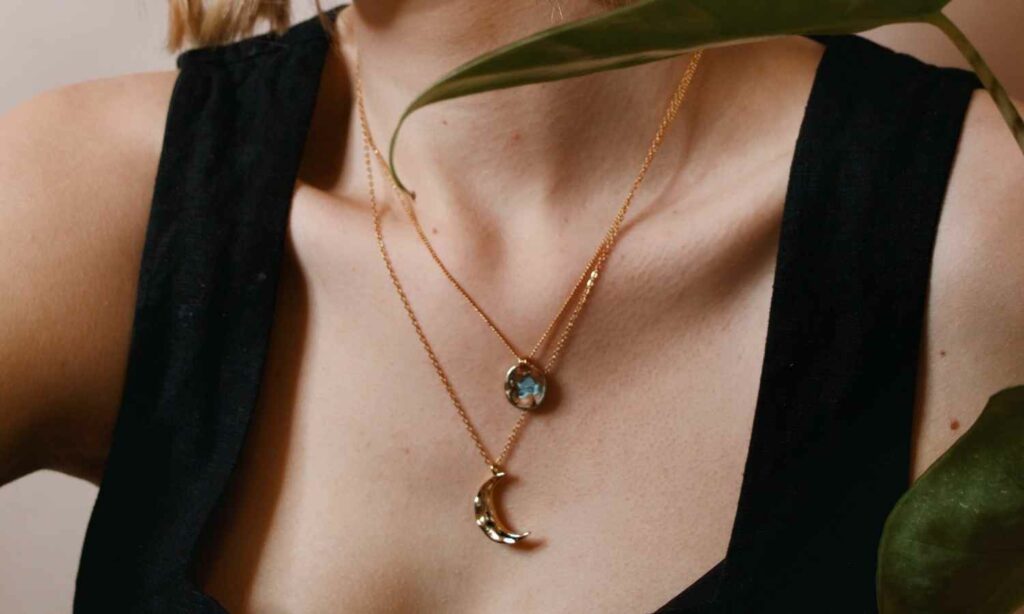Have you heard the terms “gold-filled” and “gold-plated” and are not quite sure of the difference? Well, you’ve come to the right place. Below, we review and break down gold filled vs gold plated.
The main thing to note is the discrepancy between the quantity of gold in each, but we’ll go into more detail further on. Keep reading to find out the pros and cons of both types of jewelry––what type of glam do you want decorating your accessories drawer?
Gold Filled vs Gold Plated Jewelry
What is Gold-Filled?

Gold-filled jewelry consists of 2-3 layers of solid gold pressure-bonded to a jeweler’s core of a different material––typically high-quality brass.
Gold-filled requires that the item contains at least 5% of gold by weight. This is a highly regulated requirement, so rest assured you’re getting your money’s worth. The vast majority of gold-filled products are 14K (approximately 95%).
Though its name suggests the gold resides on the inside, gold-filled actually means the opposite. All of this precious metal layers the outside of your jewelry.
Gold-Filled Pros
- Due to the thick layering of gold, this type of jewelry is highly durable.
- Safe for people with allergies or sensitive skin.
- It’s real gold so won’t flake or turn your skin green!
- Ideal balance for quality and value; you get a real-gold outer layering (and the appearance of solid gold) for a cheaper price.
Gold-Filled Cons
- Because gold-filled is not solid gold, the color will start to fade between 20 and 30 years.
RELATED: 18 Best Minimalist Jewelry Brands
What is Gold-Plated?

To make gold-plated jewelry, manufacturers deposit a small layer of gold onto the surface of the jewelry using an electric current.
Typically, gold-plated jewelry derives less than 1% of its weight from gold––the top layer is so thin that it can sometimes be scratched off, revealing a brass, copper, nickel, or silver base. There is very little real-gold value in gold-plated jewelry.
Gold-Plated Pros
- Gold-plated jewelry is substantially more affordable than gold-filled.
- It has the glamorous appearance of gold at a cheaper price.
Gold-Plated Cons
- Gold plating can be easily scratched off from the base.
- You can’t be sure how much gold is in a plated layer since the amounts are not regulated or consistent.
- Your gold plating will only last about 2 years before it begins to tarnish.
- Once gold plating wears off, the base metal can start to stain your skin green.
What is Vermeil?
Vermeil gold, or silver-gilt/gilded silver, is also a common term you might come across while jewelry shopping. Pieces that are made from vermeil gold consist of pure or sterling silver plated in gold metal. This sounds a lot like gold-plated jewelry, but there are some key differences.
For example, to be considered vermeil gold in the United States, the gold plating of the jewelry must be at least 2.5 microns thick and 10K or higher in purity.
On the other hand, there are no requirements for weight or quantity of gold for gold-plated jewelry. Plus, gold-plated jewelry typically uses a lower-quality base metal, whereas vermeil uses silver.
The Bottom Line
If you’re searching for a bit of glam for a special occasion and you aren’t super invested in the longevity of your jewelry, gold-plated is the way to go. It’s affordable and, best of all, it looks classy.
However, if you’re hoping for a durable, long-lasting statement piece, gold-filled jewelry is truly worth the extra cash. It won’t chip, contains a substantial amount of real gold, and it won’t turn your skin green.
Up Next: 8 Jewelry Trends To Know in 2021 (Chains, Pearls, and More)

